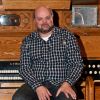Putting Jeremiah’s journey to music
TORONTO - The idea to capture the voice of “the weeping prophet” Jeremiah came to composer Peter Togni back when he was 19 and listening to Jeremiah’s lamentations as composed by Orlando di Lasso.
“It just blew me away, and I had this idea tucked way in the back of my brain that maybe one day I would end up writing that,” said Togni.
“No matter what religion you are or aren’t, the message of Jeremiah, to me, is a universal one. It’s really about somebody who tells the truth, and is disregarded. That’s the whole piece, in a way.”
In his work Lamentatio Jeremiae Prophetae, Togni, who was recently the recipient of the Queen Elizabeth medal, has charted the journey of the prophet in a four-movement concerto for bass clarinet and choir, the third of which will be showcased during Toronto’s Nuit Blanche art festival on Sept. 29-30.
“It’s the personal journey of Jeremiah through various stages of his experience of being a prophet. Imagine waking up one day and discovering that you’re called by God to be a prophet; it’s a rather difficult thing to have to assume,” said Jeff Reilly, renowned bass clarinetist, who is on both the original recording with the Elmer Iseler Singers and will be performing with the Nathaniel Dett Chorale during Nuit Blanche.
The composition has a profound effect on Reilly, as Togni (a long-time personal friend and musical collaborator) wrote the piece for Reilly specifically.
“For him to write something for me was probably a very natural extension for him of our working relationship, and, for me, probably the greatest gift I’ve ever received from any human being in my entire life was that piece,” said Reilly.
“I still look at it as an act of grace — that that piece exists.”
The four movements of the concerto act as a vehicle for Jeremiah’s suffering, contemplation and eventual acceptance of the task set before him. Togni deftly weaves the Latin text of the choir with the bass clarinet as the voice of Jeremiah — both areas work as a counterpart to the other to advance the plot and emphasize the prophet’s journey.
“In one way, it’s a virtuosic concerto… it stems from the early meanings of the word concerto which means to play together,” said Togni. “Sometimes the choir is kind of like a Greek chorus, like an architect of the space. The bass clarinet is Jeremiah, speaking in that space.”
Togni also notes that the concerto is reflective of a 21st-century paradigm, wherein he is able to allow Reilly a great element of creative control in his own right.
“The piece is 75 per cent composed, and 25 per cent improvised. Jeff is 25 per cent improvised, so he feels things in the moment. It’s kind of as if I would write a concerto for Miles Davis,” said Togni. “There’s an awful lot of trust.”
“That’s a hard thing to do,” said Reilly of the juxtaposition of sung phrase, to the instrumental evocation of Jeremiah. “They’re singing words… and they have a certain way of working and thinking as an ensemble. There is a real challenge there.
“It’s an extraordinary piece of music, and it’s an amazing performance piece.”
The original recording of Lamentatio was on the renowned ECM label, and was the first work by a Canadian composer to appear there. At Nuit Blanche, the Nathaniel Dett Chorale (which was founded by Brainerd Blyden-Taylor, artistic director) is working the movement into their set titled Oblivion, which is an exploration of silence.
“The third movement is Silentio, the one that I’m playing this weekend, and that’s his acceptance of grace,” said Reilly. “It’s a very powerful and a very beautiful movement. He takes refuge in the silence of the Lord.”
Lamentatio will also be featured at the opening gala of the Winnipeg New Music Festival in January, where it will be performed again by the Elmer Iseler Singers.
“The truth of the matter is that we’re all called upon to certain roles in our life that we don’t necessarily want to take on. But, by the grace of things beyond yourself, you have found yourself in a position to take on responsibilities, and assume a part of yourself that is bigger than the way you looked at yourself before,” said Reilly.
“It’s a beautiful story and it’s something that I think we can all relate to in a personal way. We all have to take on roles that we don’t particularly want to.”
For more information on the Nuit Blanche performance, see www.scotiabanknuitblanche.ca.
New musical Mass settings remain a work in progress
Sept. 25, 2011 marked the launch of the newly minted musical settings that followed the complete liturgical overhaul of the Roman missal.
In parishes around the archdiocese of Toronto, congregants were greeted with the small, floppy Celebrate in Song hymnal — a book that contains three freshly commissioned musical settings of the Mass. Much like the often overlapping of the spoken “and with your spirit” with the erstwhile “and also with you,” the musical settings presented congregants with a fresh challenge — adapting responses that had been previously learned en rote to a completely different, and sometimes complex, vocal line.
“I think that for people, change is death. Change is a metaphor for death. Nobody likes change,” said Peter Togni.
Togni is one of Canada’s most noted composers, and his choral works are heard in parishes across the world. Having set the Mass to music before, Togni provides an interesting view on the musical tradition that some congregants are still adapting to.
“I think the language that they’re using, in many cases, is more elegant and more directly translated from the original Latin, which goes back to what Paul VI really wanted,” said Togni.
“But, I understand the paradox, because in some ways there’s kind of a wooden link to Latin for some people — the sacrilization of Latin, almost, just for its own sake and I understand that this gets in the way of ecumenism for some people. But, from an artistic standpoint, setting the text to those words is in some ways easier and prettier, you know? ‘Lord, God of Hosts’ is easier than ‘Lord, God of Power and Might.’ I like that from a purely artistic standpoint.”
However, the adaptation, despite what may seem a more poetic version, hasn’t necessarily lent itself in all cases to the accompanying musical line. Thus, there lies an imperfect synthesis of text and music which is crucial to the participation of the congregants.
“One of them that I’ve heard, I find very awkward,” said Togni. “In the congregation that I go to now, the congregation doesn’t sing very much with one of the Mass parts because there’s so much for them to do that I find it’s overwhelming for them, and frankly, most people don’t sing.
“I think it’s the integration with the music and that text,” Togni said of what may be the inherent problem with the adjustment to the changes.
“I think different composers might have done different things with that text. Not that the text is perfect… you can get in sort of a dualistic all or nothing thinking — this is totally right, that’s totally wrong. I don’t think you can do that.”
Togni does note that the textual changes certainly serve to unite the Church across the country.
“You’re talking about universality, right? The beautiful thing about the new text, if we’re asked, is, for the French they always say ‘avec votre esprit.’ We now say, ‘and with your spirit,’ but the French have been saying it for years. So, it links us up with them,” said Togni.
Looking forward, Togni suggests that perhaps the music will adopt a more Gregorian tradition and create a solid chant-like structure that would accommodate and highlight the textual changes.
“Even if you read the Vatican documents, the chant is supposed to have lots of room. We had an opportunity to write an English setting that I think could have been more people friendly and more chant-like,” said Togni.
“No matter what you do to ‘people of goodwill,’ it’s hard to set. But, then, English is cumbersome anyway,” he laughs. “I get the sense that there’s something sort of artificial with what they ended up with.”
It’s not entirely unsuccessful, though. In particular, the Angeles “Agnus Dei” has been particularly well received by congregations that Togni’s witnessed, and musically well executed.
Despite that, perhaps the root of any musical problem in the liturgy lies with what could be described as a lagging musical culture in the Catholic tradition.
“Church choir attendance is getting smaller and smaller and smaller, in some places,” said Togni.
“In our culture, we’re not a singing people. We’re just not… I think we need to find a Mass setting that’s more people friendly, melodically; simpler rhythmically. Let’s face it — not many people sing any more.”
Another factor of the tradition that could be remedied is a less performance-like aspect to the melodic line, which would allow the cantor to interact more thoroughly with the congregants, some of whom may be averse to singing entirely, he said.
“In the Gloria, for example, I don’t know why there isn’t more refrain for the people and then the cantor or the choir can do the rest of it,” said Togni.
“It’s just so much easier. If you’re going to have the entire text, then you better make it singer friendly, and it’s not,” said Togni, who notes that some of the song selections in Celebrate in Song lend themselves well to congregant participation.
Hopefully, the new settings will entrench themselves in the musical tradition. That, or adapt to what the congregants need.
“What is that Latin phrase? ‘Lex orandi, Lex credendi’: the law of prayer is the law of belief — what we say in prayer expresses what we believe. That’s really the crux of it,” said Togni.
“It doesn’t sound like an entirely successful experiment, artistically, so far. Not yet.”


